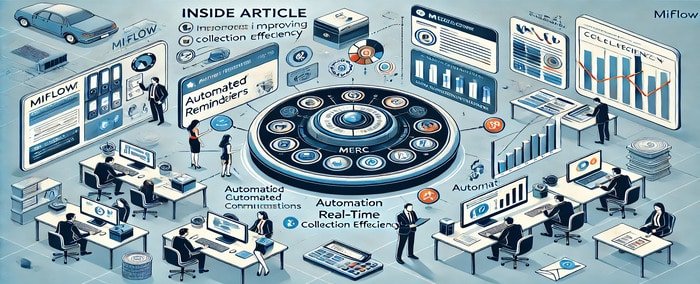miflow (MERC): MFI Collection Repository Techniques in 2024

Microfinance institutions (MFIs) play a crucial role in providing financial services to those who are often overlooked by traditional banks. These services include loans, savings, and insurance, primarily targeting low-income individuals and communities. But with the growing demand for more efficient ways to collect and report financial data, there has been a significant need for advanced techniques. In 2024, the introduction of mfi collection repository (MERC) brings a revolution in how MFIs manage their collection and reporting processes.
One of the core components of Miflow (MERC) is the mfi collection repository, which provides a centralized platform for all collection and reporting activities. This system not only streamlines the data collection process but also ensures that reporting is both accurate and timely. In this blog post, we will explore the importance of the MFI collection repository and how it is transforming the way MFIs operate.
What is the MFI Collection Repository?
The MFI collection repository is a digital database where all microfinance collection data is stored and accessed. It is an essential tool for MFIs that need to keep track of payments, outstanding loans, interest rates, and other crucial financial information. By having all this data in one place, MFIs can easily monitor their financial health, manage collections more effectively, and make informed decisions based on accurate reports.
The MFI collection repository allows for the automation of many tasks that were previously done manually. For instance, loan repayment schedules, interest calculations, and transaction logs can all be handled by the system. This reduces the risk of human error, ensures consistency, and speeds up the overall process.
How Does Miflow (MERC) Enhance the MFI Collection Repository?
Miflow (MERC) is designed to take the MFI collection repository to the next level. With its advanced features, it simplifies the data management process, making it more efficient and user-friendly for MFIs. Let’s take a closer look at some of these features:
Automation of Collection Processes One of the most significant benefits of Miflow (MERC) is its ability to automate the collection process. Payments are tracked automatically, and any missed payments or overdue loans are flagged for follow-up. This eliminates the need for manual tracking, reducing administrative burdens and the chances of errors.
Real-Time Reporting Miflow (MERC) offers real-time reporting, allowing MFIs to generate accurate financial reports whenever needed. With this feature, managers can monitor the performance of their loan portfolio, identify trends, and make decisions faster. Real-time reporting also helps with compliance, as it ensures that MFIs meet regulatory requirements on time.
Data Security The security of financial data is a top priority for any MFI. Miflow (MERC) ensures that all data stored in the MFI collection repository is encrypted and protected from unauthorized access. This level of security not only protects sensitive customer data but also builds trust with clients.
User-Friendly Interface The platform is designed to be simple and easy to use. Even users with minimal technical knowledge can navigate the system efficiently. This accessibility means that staff at all levels can interact with the MFI collection repository without facing steep learning curves.
Customizable Reporting Different stakeholders may require different types of reports. Miflow (MERC) offers customizable reporting options, so that MFIs can generate reports tailored to the needs of their organization. Whether it’s a detailed financial statement or a summary of loan repayments, Miflow (MERC) can accommodate it all.
The Role of Miflow (MERC) in Improving Collection Efficiency
Microfinance institutions are often faced with challenges when it comes to loan collections. Late payments, difficulty tracking payments, and lack of transparency can all lead to significant financial losses. However, the MFI collection repository within Miflow (MERC) helps mitigate these challenges by offering several key benefits:
1. Better Loan Monitoring and Follow-Up
With Miflow (MERC), the loan collection process is made easier and more efficient. Loan officers can monitor outstanding loans and follow up with clients who are behind on their payments. This ensures that payments are made on time, improving the overall financial health of the institution.
2. Reduced Risk of Default
By offering a clear overview of all transactions and loan statuses, the MFI collection repository can help identify which loans are at risk of default. Early detection allows the MFI to take corrective action, whether through renegotiating loan terms, offering payment plans, or even using a debt recovery service.
3. Increased Client Engagement
Clients can access their payment history and loan balance through the Miflow (MERC) platform, creating more transparency. This increases trust between the MFI and the client, as customers can track their progress and feel confident in the MFI’s ability to manage their funds.
4. Better Cash Flow Management
With real-time tracking and reporting, MFIs can better forecast their cash flow. By understanding when payments are due and tracking overdue accounts, the institution can avoid liquidity problems and ensure they have the funds available to meet operational costs.
The Future of Miflow (MERC) and MFI Collection Repositories
As we move further into 2024 and beyond, we can expect even more advancements in Miflow (MERC) and the MFI collection repository. Here are a few areas where we might see innovation:
1. Integration with Other Financial Systems
Miflow (MERC) could integrate with other financial management systems, allowing for seamless data exchange. For example, integrating with accounting software would streamline financial reporting, making it even easier for MFIs to manage their finances.
2. Mobile Access for Clients
As mobile technology continues to evolve, we can expect to see more mobile-friendly features in Miflow (MERC). This would allow clients to make payments, check balances, and communicate with the MFI directly from their mobile phones, improving accessibility and convenience.
3. Use of Artificial Intelligence and Machine Learning
In the future, we might see the incorporation of AI and machine learning in Miflow (MERC). These technologies could analyze trends in client behavior, predict defaults, and even recommend personalized loan terms based on a client’s payment history and financial situation.
Conclusion: Why Miflow (MERC) is Essential for the Future of Microfinance
Miflow (MERC) is transforming the way MFIs collect and report data. The MFI collection repository is a game-changer in the microfinance sector, offering more efficiency, accuracy, and security. With its ability to automate processes, provide real-time reports, and enhance loan collection, it helps MFIs improve their operations and better serve their clients. As we look towards the future, Miflow (MERC) will continue to play a crucial role in the growth and success of microfinance institutions around the world.






